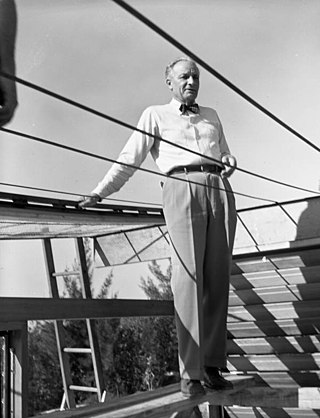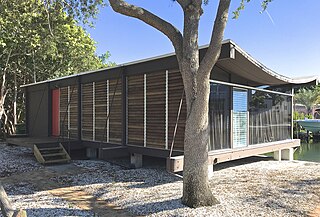
Sarasota is a city in and the county seat of Sarasota County, Florida, United States. It is located in Southwest Florida, the southern end of the Greater Tampa Bay Area, and north of Fort Myers and Punta Gorda. Its official limits include Sarasota Bay and several barrier islands between the bay and the Gulf of Mexico. Sarasota is a principal city of the Sarasota metropolitan area. According to the 2020 U.S. census, Sarasota had a population of 54,842.

Morris Lapidus was an architect, primarily known for his Neo-baroque "Miami Modern" hotels constructed in the 1950s and 60s, which have since come to define that era's resort-hotel style, synonymous with Miami and Miami Beach.
Charles Willard Moore was an American architect, educator, writer, Fellow of the American Institute of Architects, and winner of the AIA Gold Medal in 1991. He is often labeled as the father of postmodernism. His work as an educator was important to a generation of American architects who read his books or studied with him at one of the several universities where he taught.

Paul Marvin Rudolph was an American architect and the chair of Yale University's Department of Architecture for six years, known for his use of reinforced concrete and highly complex floor plans. His most famous work is the Yale Art and Architecture Building, a spatially-complex Brutalist concrete structure. He is one of the modernist architects considered an early practitioner of the Sarasota School of Architecture.

Mid-century modern (MCM) is a movement in interior design, product design, graphic design, architecture and urban development that was popular in the United States and Europe from roughly 1945 to 1969, during the United States's post–World War II period. The term was used descriptively as early as the mid-1950s and was defined as a design movement by Cara Greenberg in her 1984 book Mid-Century Modern: Furniture of the 1950s. It is now recognized by scholars and museums worldwide as a significant design movement. The MCM design aesthetic is modern in style and construction, aligned with the Modernist movement of the period. It is typically characterized by clean, simple lines and honest use of materials, and it generally does not include decorative embellishments.
Gene Leedy was an American architect based in Winter Haven, Florida. He was a pioneer of the modern movement in Florida and later a founder of the Sarasota School of Architecture, whose members included Paul Rudolph, Victor Lundy, and others. After beginning his career in Sarasota, Leedy moved his practice to Winter Haven in 1954. He is best known for his bold use of exposed structural systems of precast concrete, especially in long-span, "double-tee" structural elements, as well as enclosed courtyards, flat roofs, and floor-to-ceiling sliding glass doors.

Michael David Sorkin was an American architectural and urban critic, designer, and educator. He was considered to be "one of architecture's most outspoken public intellectuals", a polemical voice in contemporary culture and the design of urban places at the turn of the twenty-first century. Sorkin first rose to prominence as an architectural critic for the Village Voice in New York City, a post which he held for a decade throughout the 1980s. In the ensuing years, he taught at prominent universities around the world, practiced through his eponymous firm, established a nonprofit book press, and directed the urban design program at the City College of New York. He died at age 71 from complications brought on by COVID-19 during the COVID-19 pandemic.

The Sarasota School of Architecture, sometimes called Sarasota Modern, is a regional style of post-war modern architecture (1941–1966) that emerged on Florida's Central West Coast, in and around the city of Sarasota, Florida. It is characterized by open-plan structures, often with large planes of glass to facilitate natural illumination and ventilation, that address the unique indigenous requirements of the regional climate. Many of the architects who pioneered this style became world-renowned later in their careers, and several significant buildings remain in Sarasota today.

Cà d'Zan is a Mediterranean revival residence in Sarasota, Florida, adjacent to Sarasota Bay. Cà d'Zan was built in the mid-1920s as the winter retreat of the American circus mogul, entrepreneur, and art collector John Ringling and his wife Mable Burton Ringling. The name Cà d'Zan means "House of John" in the Venetian language, in Italian it would be "Casa di Giovanni".

The Revere Quality House is a house located in Siesta Key, Florida that was designed by architects Paul Rudolph and Ralph Twitchell. It is a breakthrough in twentieth-century residential architecture which blends elements of the International Style with site-sensitive design that is considered one of the notable examples of the Sarasota School of Architecture. The house represents a substantial advancement in how people should live within their environment, and established a new paradigm in tropical home construction.
Richard Sammons is an architect, architectural theorist, visiting professor, and chief designer of Fairfax & Sammons Architects with offices in New York City, New York and Palm Beach, Florida. The firm has an international practice specializing in classical and traditional architecture, interior design and urban planning. Sammons was instrumental in the reemergence of classical design as a major movement in America through his designs as well as his work as an instructor at the Prince of Wales Institute in Britain in 1992-3 and as a founding member of the Institute of Classical Architecture in 1991. From 1996 to 2004, the Fairfax & Sammons office also served as the headquarters for the noted American architecture critic Henry Hope Reed Jr. (1915) and Classical America, the organization he founded in 1968. In 2013, Fairfax & Sammons received the Arthur Ross Award for Lifetime Achievement in Architecture, an award created to recognize and celebrate excellence in the classical tradition.
Jack West was an architect in Sarasota, Florida and briefly in Southern California. West was one of the leaders of the Sarasota School of Architecture.

Ralph Spencer Twitchell was one of the founding members of the Sarasota School of Architecture. He is considered the father of the group of modernist architecture practitioners, that includes Paul Rudolph and Jack West, and other modernist architects who were active in the Sarasota area in the 1950s and 1960s like Ralph and William Zimmerman, Gene Leedy, Mark Hampton, Edward “Tim” Seibert, Victor Lundy, William Rupp, Bert Brosmith, Frank Folsom Smith, James Holiday, Joseph Farrell and Carl Abbott. He bridged the more traditional architecture of his early work in Florida during the 1920s with his modernist designs that began in the 1940s.

William J. Rupp was one of the modernist American architects considered part the Sarasota School of Architecture.
Guy Wesley Peterson is an American architect based in Sarasota, Florida. He has designed more than 200 structures in southwest Florida, including private and public works. Peterson was an adjunct professor of architecture at the University of Florida, College of Design, Construction and Planning, and the author of Naked: The Architecture of Guy Peterson.
Edward John "Tim" Seibert was an architect based in Sarasota, Florida. Seibert was a Fellow of the American Institute of Architects and one of the founders of the modern movement known as the Sarasota School of Architecture.

The Healy Guest House is a small guest cottage located in Siesta Key, Florida, originally built for Mr. and Mrs. W. R. Healy. It was designed in 1948 by Paul Rudolph and Ralph Twitchell during their five-year partnership that sparked a modern architecture movement in Florida; the Sarasota School of Architecture. Its radical shape, featuring an inverted catenary roof, was an experiment in structure and technology. It is considered one of the most significant architectural works of the twentieth-century.

Lamolithic house was the term given by Sarasota concrete businessman John Lambie to describe his unique method of building modern reinforced concrete residential structures. This building technique enabled the fabrication of thin ceiling and wall planes, thus enabling architects to draft efficient and lightweight designs. Several historic lamolithic houses were constructed by renowned architects Paul Rudolph and Ralph Twitchell on Siesta Key, Florida using this technique. These homes were among the earliest examples of reinforced concrete residential construction.

The Hiss Residence is a mid-century modern home designed by architect, Paul Rudolph. Built as the show home for Sarasota's Lido Shores neighborhood in 1953, the structure blends international style modernism with indigenous tropical design. It is among the preeminent works of the Sarasota School of Architecture and considered “one of the most remarkable homes of the twentieth century.”

Milam Residence is an oceanfront residence in Ponte Vedra Beach, Florida, United States. It was designed by architect Paul Rudolph in the style of Sarasota Modern. The late modernist home has an unusual facade of large geometrical shapes facing the ocean. Completed in 1961, it was one of Architectural Record's 20 "Record Houses" of 1963. In 2016, it was added to the National Register of Historic Places.




















